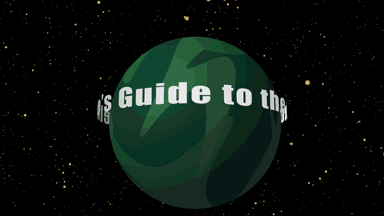Scienceline’s Guide to the Exoplanets: Exotic Waters
GJ 1412 b: Oceans like nothing you've seen on Earth
Rahul Rao • June 8, 2020

Your favorite planets, and you didn't even know they existed. [Credit: Curtis Segarra | CC BY-NC-ND 2.0]
Your favorite planets, and you didn't even know they existed. [Credit: Curtis Segarra | CC BY-NC-ND 2.0]
Exotic Waters
Gliese 1214 b/GJ1214b
Discovered by: David Charbonneau, et al.
Discovered: 2009
Distance from Earth: ~47 light-years
Size: ~2.7 Earth radii
Mass: ~6.2 Earth masses
Surface climate: Water is wet
Habitability for humans: Not unless you like hot ice
In your childhood, you perhaps learned that about two-thirds of Earth’s surface is covered by water: not just the vast oceans, but ice caps and river systems and even the water vapor that dots the atmosphere in clouds. When you look at Earth from space, oceans dominate it. There’s a reason Earth has been called “blue marble” and “pale blue dot.”
If you were an extraterrestrial in a far distant star system looking back at the Earth with technology similar to ours, picking apart only the scantest details about distance from the Sun and surface temperature and atmospheric composition, you might reasonably think the entire planet is covered by water: that Earth is an ocean world.
But astronomers believe there’s a different kind of ocean world orbiting other suns. These aren’t like Earth. Earth is really a world of rock and metal that just happens to be painted over with a thin coat of water. Only a fraction of a percentage of Earth’s mass is actually water. No, these ocean worlds are more like very large comets, where the majority of the planet’s mass is water.
There’s a few known planets that could be ocean worlds, but today we’re looking at a single one: GJ 1214 b, orbiting a red dwarf within the Sun’s local neighborhood. GJ 1214 b is a “super-Earth,” a planet that’s bigger than Earth but likely still solid and terrestrial, rather than a gas giant. (In 2009, it was, in fact, only the second super-Earth to be discovered.)
It’s not certain what GJ 1214 b actually looks like, but some astronomers think the outside of the planet is dominated by a thick atmosphere composed of water vapor. It helps that the planet is likely about the temperature of Mercury. While this was cooler than the hot Jupiters that utterly dominated the lists of known exoplanets in 2009, it is still well more than warm enough to boil water. As such, if there’s water on the surface or even near the surface, it’s likely been vaporized.
But what happens if GJ 1214 b is an ocean world — and if you start going deeper down? Eventually, you’ll hit a thick layer of liquid water. But if you go below that, you’ll probably start entering a much stranger world: a world of exotic ice.
You might be used to thinking of ice as the hexagon-shaped crystals that form on especially chilly days on Earth. (Scientists call this ice Ih.) But by playing with pressure, you can actually create at least 18 phases of ice, many with alien crystal shapes: cubes, pyramids, and some that don’t even form crystals at all but instead amorphous blobs. If you make the pressure high enough, some of these ices can exist at room temperature — and some of these can exist at temperatures hot enough for water on Earth to boil.
On an ocean world like some believe GJ 1214 b to be, if you dive down to where pressures are high enough — say, 100,000 times Earth’s atmosphere — you might find yourself surrounded by unearthly cuboids of ice VII (pronounced “ice-seven”). Ice VII has actually been found to naturally occur in diamonds, and some scientists think it exists deep within Jupiter’s moon Europa.
Go even deeper, and even with temperatures hot enough to melt metal you might find yourself in frozen clouds of ice X.